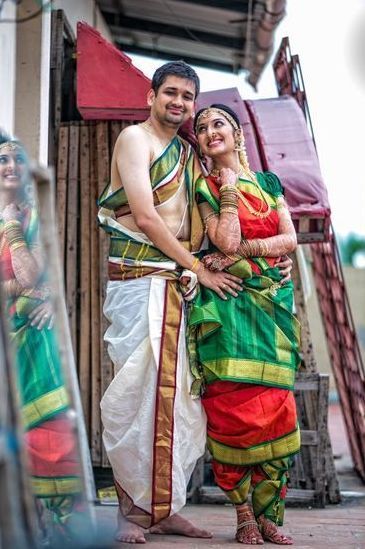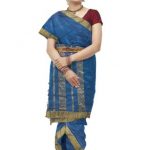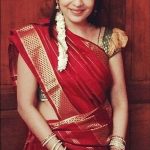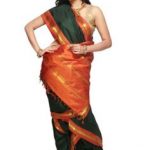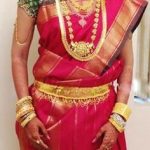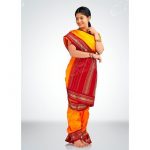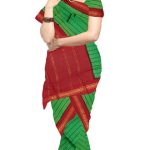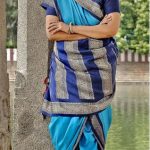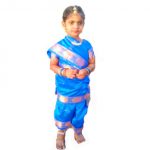Madisar Saree, also known as Koshavam Saree, is one of the traditional sarees performed by Tamil Brahmins. The Saree style originated in the middle of the 2nd century BC. AD to 1st century AD During this phase, Antariya and Uttariya garments were combined to create a single garment. The old Madisar Saree pictures show that the Saree by Jnanadanandini Devi comes from the Tagore family.
Madisar saris are mostly wrapped by the Iyers and Iyengars, with a slight difference in Pallu dressing. Initially, the madisar was worn in either maroon or red; However, it is now available in different colors and patterns, depending on the choice of wearer and occasion.
Meaning of Madisar Sarees:
The Madisar Saree was worn by the South Indian women only for wedding purposes. It later became symbolic and practical, revealing protection and modesty. This 9-yard saree is the symbol of the unity of the principles of man and woman in the universe because it is both the shape of a dhoti and a pallu. It is also performed for a number of religious traditions in Chennai as it resembles Ardhanareeswara.
Features of Madisar Sarees:
The Madisar Saris have a number of characteristics related to their tradition and religion. Here are some popular ones.
- The Madisar Saree can now be worn with a 6 yard saree instead of a 9 yard saree
- The clothing of this saree from the front looks like a shell that connects it with some religious principles such as Shri Krishna Tattva, Lakshmi Devi Tattva, Chaitanya and Marak-Shakti.
- Again, it is believed that worshiping while wearing the Madisar Saree Collection would activate the Pancha Prana in the body
- Isn’t this a highly religious and meaningful saree?
What is the most common substance used for the Madisar Sarees?
The Madisar Saree collection is available in different fabrics. Starting from pure cotton, polyester-cotton, silk, cotton silk and various other blends can also be obtained. The saree was a priory made of pure cotton, with only very simple prints. This made it easy for women to drape it and keep it fresh in summer. However, with the changes in designs and styles, they were later available in other fabrics, which increased the demand on various occasions.
What body shape do women prefer this saree?
Most women in India are healthy and curvy. And Madisar Saree is one of the sarees that give every shape a perfect look. Undoubtedly, this saree was previously only allowed for women after marriages, but the situation has now changed. No matter whether you are a slim and healthy woman or a healthy and curvy woman, this saree is suitable for every woman. The woman with the heavy brim generally prefers to wear the 9-yard saree, while 6-yard is sufficient for the slim and medium body.
How do I wear Madisar Sarees?
- Madisar Saree is a combination of Iyer and Iyengar styles of saree draping.
- Are you thinking about how to wear Madisar Saree? For women trying to wear this saree, this can be a good time to exercise, as it involves over-bending, turning, moving your arms here and there, etc.
- The most popular of all is the Dhoti style, in which the saree is folded between the legs and stowed behind. The other end of the saree is hidden at the waist to get a belt like a look.
Which blouse goes with the Madisar Saree?
Just look at one of the Madisar Saree photos and you will find that the Saree traditionally does not contain a blouse. Over time, however, women wore blouses. Depending on the Madisar type, simple designer blouses are currently worn, which either represent a combination of saree color and design or in contrast. Just as the Saree is available in different materials, the blouses are available in different materials.
Nowadays women like to look at Madisar Saree as a traditional and antique styling outfit. Madisar has a strong base of religious facts that are very important. The saree is compared to a series of rituals and sacred things, making it an important blessing for the bride, which is why it is given to her for the first time on her wedding day. The saree is also worn with pride at other festivals, such as Varathas, Karthigai Pandigai, Pongal, baby showers etc. The cotton and synthetic material sarees are mostly worn for regular wear or during death ceremonies. The saree is a perfect combination of feminism and spirituality.
 sanideas.com Fashion Ideas
sanideas.com Fashion Ideas
